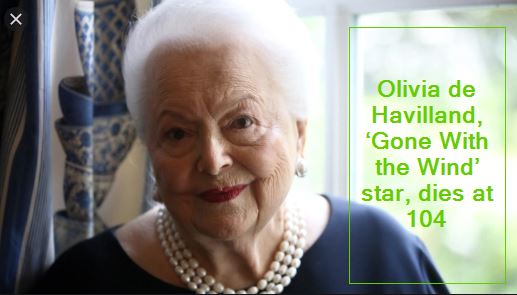Olivia de Havilland, ‘Gone With the Wind’ star, dies at 104
Olivia de Havilland, 1945
Olivia de Havilland, an iconic actress during Hollywood’s Golden Age, is photographed at the Daily News’ studio on May 10, 1945. De Havilland began her storied life with her birth to British parents on July 1, 1916, in Japan, and a childhood focussed on the arts. Her younger sister, Joan Fontaine, born 15 months later, sparked a lifelong, public rivalry. They are the only siblings that have both won Academy Awards in a leading category. Nominated four times for an Academy Award, de Havilland won the award for Best Actress in a Leading Role for both “To Each His Own” (1946) and “The Heiress” (1950). Among her 49 feature film roles, de Havilland is also well-known for her role as Melanie Hamilton in “Gone with the Wind” (1939). She appeared on Broadway in three plays, including “Romeo and Juliet” (1951) as well as in TV roles such as the TV film, “Anastasia: The Mystery of Anna” (1986) where she won both a Golden Globe Award and Primetime Emmy Award for Best Supporting Actress. She received a star on the Hollywood Walk of Fame in 1960. She was honored in 2008 with a National Medal of Arts by President George W. Bush. On June 17, 2017, at almost age 101, she became the oldest person to be appointed a Dame Commander of the Order of the British Empire, an honor bestowed by Queen Elizabeth.
Olivia de Havilland, one of the last remaining actresses of Hollywood’s Golden Age, two-time Oscar winner and star of “Gone With the Wind,” has died in Paris, he publicist confirmed. She was 104.
The long-lived actress, who had a famously tempestuous relationship with her sister Joan Fontaine, mounted a lawsuit against the producers of the 2017 series “Feud” over her portrayal by Catherine Zeta-Jones. She argued that producers did not have her approval over her depiction and that the show damaged her “professional reputation for integrity, honesty, generosity, self-sacrifice and dignity.” The case was rejected by California’s high court in July 2018, but she vowed to take it to the Supreme Court.
[amazon box=”B07SDFC9QT” “small”]
The striking brunette won best actress Oscars for “The Heiress” and “To Each His Own” in the late 1940s, and was Oscar-nominated for “Gone With the Wind,” “The Snake Pit” and “Hold Back the Dawn.”
She was known for her sincerity, fragile beauty and beautiful diction, and for bringing dimension to sympathetic characters. When she made a rare foray into villainous roles, she was expert. But the public preferred her as a heroine, which suited her well, since she said it was harder to play “a good girl” rather than a bad one.




